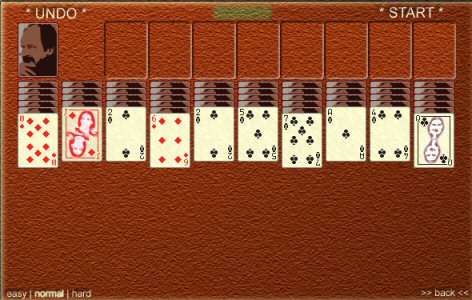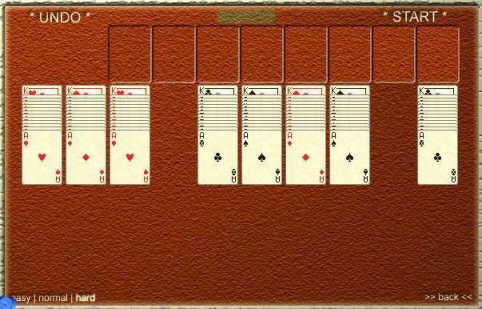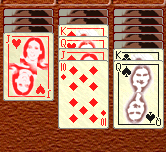Mogelpat
Il gioco
Mogelpat is one of many patience variations. The aim is to form rows of pure colors without having to use too many auxiliary stacks.
Tavolo di gioco

Mogelpat can be played in three difficulty levels: easy (only one card color), normal (two card colors) or hard (all four card colors). The difficulty level is selected by simply clicking in the bottom left corner before starting the game.
To start the game, simply click on the start button and off we go: the cards are shuffled and laid out - as shown on the left.
In this solitaire there are three types Stacking cards:
- At the top left is the distribution stack on which cards that have not yet been laid out are located.
- In the top middle are located eight auxiliary piles
- including the ten work piles
After the start there are a total of 54 cards on the work piles and 50 cards on top the distribution stack.
Svolgimento
Scopo del gioco
The aim of the game is to reveal all the cards and sort them into color-correct sequences - if possible within the work piles. The final position could look like this (it doesn't matter which sequence is on which work or auxiliary stack):

For this purpose, color-fast (Partial) sequences are rearranged. Note: even a single card represents a color-correct partial sequence ;-). However, cards or sequences may only be placed on an empty work pile or where a sequence is created again - but this does not have to be color-fast.
Example:

In this case, the Ten of Diamonds can be moved alone, for example to the Jacks of Hearts next to it. Or the diamond jack and ten can be dealt together, but only to an empty work pile or to a queen of any color. The queen of hearts and the two diamonds cannot be moved together because they form a sequence, but not a true-color sequence.
< span>Moving is done by dragging the highest value card in the sequence with the mouse to the desired position or by simply clicking on this card - then a suitable destination is automatically determined (which does not necessarily have to be optimal). If the last revealed card of a work pile is placed in a different position, the top hidden card is automatically revealed.
By clicking on the distribution pile, each of the work piles is An additional card is dealt to the stack.
Auxiliary stacks
Complete true-color sequences (i.e. from King to Ace) can be played on an empty auxiliary pile must be turned over - this creates space within the work piles and makes it easier to sort the remaining cards.
But be careful: sequences cannot be removed from the auxiliary piles be brought back to the work piles. And when scoring a game, special points are only awarded for complete sequences that are alone on a work pile, as in the final position illustration above!
< span>Undo
The patience is quite difficult and can only rarely be solved according to normal patience rules. That's why there is the option to "cheat": using the Undo button, any move can be undone, even several times (in extreme cases, back to the beginning of the patience). The withdrawal of moves is not penalized with direct deductions in points when evaluating the patience. However, since the time required is also included in the evaluation of the patience, there is at least an indirect time penalty if you take back a lot of moves.
Fine del gioco < /h3>
The game ends when all cards have been sorted into eight true-color sequences within the work piles. If you can't do that or you want to stop, you can also end the game by clicking the start/stop button.
Punteggio
The rating depends on both the time and the selected difficulty level. In any case, using the auxiliary stacks has a negative effect on the scoring.

